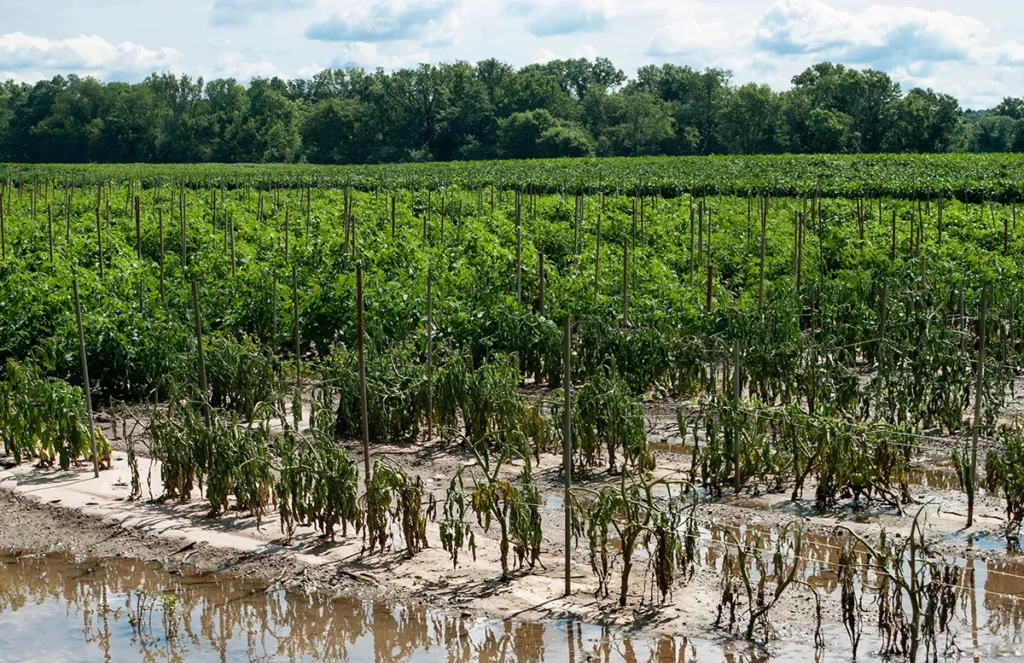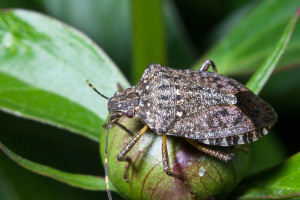
Climate Preparedness Makes Good Business Sense
The earth’s climate is always in flux, but today’s rate of change, the result of human activity, is far beyond what previous generations of farmers have had to face. Climate change is already posing new challenges, such as extreme precipitation, short term drought, heat stress, warmer winters, late spring freezes, increased pest pressures, and increased production costs. Some farmers are beginning to plan to minimize the risks and capitalize on opportunities. In the Northeastern United States, there will be plenty of both. Making business decisions based on future scenarios is always a complex endeavor, and is muddled even more by trying to discern between normal weather variability and long-term climate shifts. Many of the commodities that currently dominate the Northeast agricultural sector, such as dairy products, apples, cabbage, and potatoes, are not well suited for the warming trends predicted for this century. However, there will be profitable opportunities to experiment with new crops or new crop varieties as temperatures rise and growing seasons lengthen.
The information below is also available in a printable Cornell Climate Change Fact Sheet: Farming Success in an Uncertain Climate. For more detailed information, refer to the New York State Climate Impacts Assessment Agriculture Chapter , and the NYS ClimAID Report.

Flooding and Extreme Rainfall
A warmer atmosphere holds more water. Because of this, more precipitation is occurring in heavy rainfall events (more than 2 in / 48 hrs), and this trend is expected to continue.

Observed Change in Heavy Precipitation Map
The map shows percent increases in the amount of precipitation falling in daily events that exceed the 99th percentile of all non-zero precipitation days (top 1 percent of all daily precipitation events) from 1958 to 2016 for each region of the United States. The number in each black circle is the percent change over the entire period (1958–2016).
Flooding Challenges:
- Springtime flooding can delay planting and harvesting
- Root damage and reduced yield due to flooding
- Farm building and infrastructure damage
- Soil compaction from the use of heavy machinery on wet soils
- Soil loss from erosion during heavy rain events
- Contamination of waterways from agricultural run-off
Flooding Solutions:
- Increase soil organic matter for better drainage with practices such as reduced tillage, cover cropping, and use of composts or other organic amendments
- Invest in tile or other drainage systems for problem fields to help transport water away from crops
- Shift to more flood-tolerant crops
- Buy or lease new acreage with better drainage
- Shift planting dates to avoid wet conditions

Extreme Rainfall
Flooding from extreme rainfall has damaged this tomato field in Upstate New York.

Short-term Drought
The Northeast does not face the severe water shortages predicted for some other regions, but the risk of short-term summer drought is expected to increase over this century. Warmer temperatures and longer growing seasons will increase crop water demand, while summer rainfall will remain about the same or possibly decline.
Drought Challenges:
- Declining and more variable yields of rain-fed crops
- Decline in quality of high-value fruit and vegetable crops
- Reduces crop yields and causes water shortages
Drought Solutions:
- Increase irrigation capacity, particularly for high-value crops
- Shift to drought-tolerant crop varieties
- Shift plant dates to avoid dry periods.
- Reduce tillage and plant cover crops
- Reduce the distance between rows of field crops to shade soil

Heat Stress
The growing season across the state has already increased by an average of 11.5 days over the period from 1895 to 2020. With temperatures projected to warm in all seasons, growing seasons can be expected to lengthen. The number of summer heat stress days (e.g., exceeding 90°F) is also expected to increase substantially, while winters continue to grow milder. These changes will create both opportunities and challenges for farmers.
Heat Stress Challenges:
- Warmer summer temperatures have been shown to decrease yields for certain varieties of grain crops (field corn, wheat, and oats) by speeding the development cycle and shortening the period during which grain heads mature
- Hot daytime or nighttime temperatures during critical phases of plant development can reduce the yield and quality of even “heat-adapted” crops
- Potatoes, cabbage, snap beans, apples, and other heat-sensitive plants will be more challenging to grow
- Warmer and more variable winters can (counterintuitively) increase the chance of frost and freeze damage for perennial fruit crops by inducing premature leaf-out and interfering with cold-mediated winter hardening
- Extreme heat can cause illness or even death among farm workers exposed to these high outdoor temperatures
Heat Stress Solutions:
- Shift planting dates to avoid heat stress during critical periods of plant development
- Preform labor intensive harvesting at night, using lights, when temperatures are cooler
- Explore new varieties of heat-resistant crops, and be prepared to diversify production to reduce reliance on heat-sensitive crops
- Capitalize on the opportunity to grow longer-season crops. For example, some field corn growers are already experimenting with new longer growing-season varieties
- Use protective covers on fruit crops
Heat Stress and Livestock
Heat stress can have devastating consequences for livestock. Keeping cool in the heat of the next century will be critical for maintaining the milk production levels that have made dairy the dominant industry in the Northeast’s agricultural sector.

Heat Stress and Dairy
Even moderately warm temperatures, e.g. above 75°F, when combined with moderate humidity, can lead to milk production decline. In 2005, unusually warm temperatures reduced milk production 5 to 15 lbs per cow per day for many dairies (leading to losses of 8 to 20%). The frequency of heat-stress events is expected to increase with climate change
Livestock Challenges:
- Heat stress associated with hotter summers will create dangerous and unhealthy conditions for livestock, reducing productivity and reproductive capacity
- Availability and cost of animal feed will fluctuate as climate affects crops like corn grain and silage
- New costs will be incurred from investments to improve the cooling capacity of livestock facilities
Livestock Solutions–Low Cost:
- Reduce overcrowding and improve barn ventilation
- Minimize heat exposure, e.g. feed during the cool part of the day and maximize shade
- Increase water availability and adjust diet (more fat, less protein)
- Increase water availability and adjust diet (more fat, less protein)
Livestock Solutions–Moderate to High Cost:
- Improve cooling capacity with additional fans, sprinkler or mister systems, and ventilation renovations
- Insulate under barn roofs to buffer extreme heat and save on cooling costs
- Build new barns with adequate cooling capacity for future heat loads

Disease, Pests, and Weeds
Interactions between climate, crops, insects, and disease are complex, but evidence suggests that climate change will require Northeast farmers to invest in earlier and more intensive pest and weed management. Anticipating the challenge of increased weed and pest pressure will allow for better control and more cost-effective management.

Case-Study: Brown Marmorated Stink Bug
If not for its diminutive size, the brown marmorated stink bug (BmSB) could be the subject of a 1950s horror movie. Described as “the bug from hell” after BmSB ate $37 million of the 2010 MD apple crop, the hungry bugs will munch on anything from orchard crops, to corn and soybeans. First introduced in Pa during the ‘90s, BmSBs are streaming northward, taking advantage of recent warm winters and long summers. BmSB was first sighted in NY in 2008, increasing yearly since then. Some pesticides have proven effective against BmSB, but control has been limited.
Insect Challenges:
- Spring populations of insect pests will expand, as survivorship rates of marginally over-wintering insect species increase and migratory insects arrive earlier
- A longer growing season means more insect generations per season, requiring increased intensity of management
- Higher temperatures might also allow new invasive species to move into the state. More pests can lead to more pesticide use, which poses additional health concerns
Weed Challenges:
- Warmer weather and increasing concentrations of carbon dioxide in the atmosphere favor weed growth over crop plants in many cases
- Weeds will need to be controlled for longer and weed seed production will be greater
- Certain weed species currently restricted to the warmer South are migrating northward, such as kudzu, while some familiar weed species (e.g. lambsquarters) are projected to become stronger competitors
- Pressure to use chemical control methods will increase as pest and weed infestation intensifies, and studies have shown the climate change may reduce the efficacy of certain commonly used pesticides (pyrethroids, spinosad) and herbicides (e.g. glyphosphate)
Insect and Weed Management Solutions:
- Improved rapid response plans and regional monitoring efforts will allow for targeted control of new weeds and pests before they become established
- Enhanced monitoring and implementation of integrated pest management (IPM) will help farmers balance pest and weed control while avoiding the economic, environmental, and health-related costs of increased chemical application
- Farmers can also use online pest forecast systems, but some of these tools will need to be updated to align with changing weather patterns

Freeze Risk
While global warming is causing freezes to be less severe, spring frosts and freezes are not receding as quickly as flowering is advancing, resulting in increased freeze risk. There are several things that farmers can do to minimize the effects of the first freeze. These include:
Freeze Solutions:
- Watch the calendar and the forecast – use the CSF Freeze Risk tools
- Harvest early if possible
- Irrigate before or during Irrigate the freeze event
- Use Heaters and wind machines
Read more details about frost and freeze here.

When is it Time to Make a Change
This will be a critical question for farmers. Climate scientists can provide useful information to help determine when a poor season or two is due to just “normal” bad weather, and when it is due to a shift in the climate that will likely be here to stay. At Cornell, we are working on new decision tools that will allow farmers to examine different future climate scenarios for their region, the impacts these might have on crops and livestock, and evaluate various options for timing adaptation investments to minimize negative effects or take advantage of opportunities brought about by climate change.
